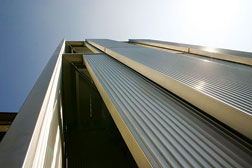 |
The design of the Seattle Art Museum’s so-called bris soleil curtain wall system, with movable stainless steel panels to block out light, is called the hairiest part of the 1.3-million-sq-ft WaMu Center-SAM Downtown expansion. To the art museum, the curtain wall is the distinguishing element between the museum and the office tower.
To others, it presented the biggest headache. That’s because it went through several design iterations and a 30% size reduction, mostly to reduce its cost. The changes would affect the structure it attaches to and the design of the museum’s mechanical system, with which it works to control the interior environment.
 |
| Fourth to fifth floor corner, with returns, was complicated to engineer. (Image above and top courtesy of Benson Industries Inc.) |
Portland, Ore.-based Benson Industries, which supplied SAM’s $12-million curtain wall, including the bris soleil, spent a full year in design development with SAM’s design architect, the architect of record, the general contractor and the mechanical engineer. “It was one of the most challenging engineering jobs Benson has ever done, and the logistics of the field installation were extremely involved,” says Jeremy Mucha, Benson’s vice president of engineering. “It’s a lot more complicated than it looks.”
That’s because the outer wall is not flat. It sets back, cants, and more. For each special case, Benson had to design a special condition.
|
The system covers two-thirds of the west face of the museum. It has three major components. The unitized glass curtain wall that encloses the building; a 30-in.-deep maintenance catwalk external to the building, that like a ledge, projects from floor slabs; and two rows of ribbed panels that bear on the catwalk’s edge. The movable panels, which slide on Teflon gliders, are adjusted manually by workers on the catwalks. The museum will likely move the panels a couple of times a year. The wall can be made completely opaque, half open or in between.
Benson says there were 20 design meetings just for the building envelope, including one that was for the birds—to devise a surface to keep them off the catwalk.
For the installation, the catwalk brackets were first attached to the glass unit at the factory. In the field, workers attached the catwalk to the glass unit and installed both. Finally, they installed the bris soleil panels. The installation went well, says Benson.

Post a comment to this article
Report Abusive Comment